Tactical flashlights may be the sexy torches on the market, but most shooters need good non-tactical flashlights for work, camping, hunting and every day life. For this reason, I’ve expanded my flashlight testing to include more “workhorse” style EDC flashlights.
In this Fenix LD15R review, I evaluate a tiny right-angle flashlight that I found to be incredibly useful in daily life. It is reasonably priced and performed admirably through more than 16 months of use.
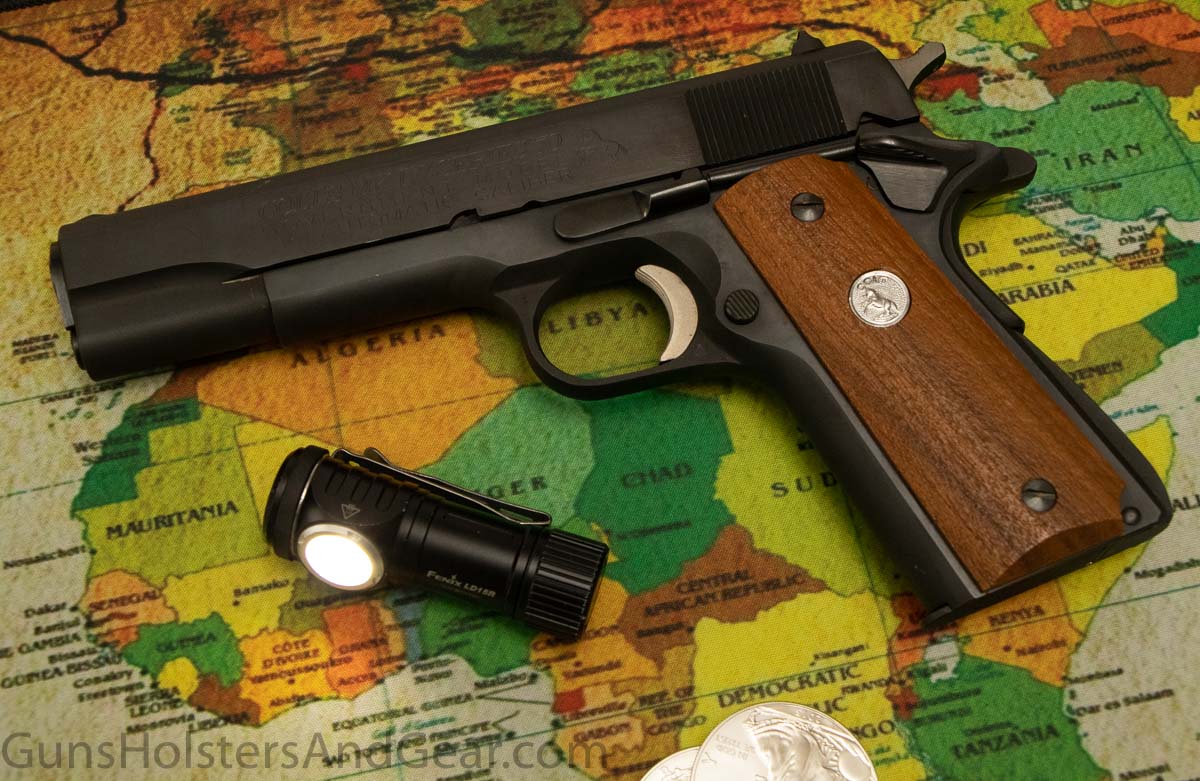
I put the light through all of the same tests that I do for a tactical light. However, I view it as a general purpose flashlight – not as a tool on which your life might depend. Even so, the LD15R made a solid backup to my tactical lights.
So, let’s get right into my LD15R review.
Quick Overview
For an EDC work light, the LD15R is an amazing flashlight. It proved itself time after time in more than 16 months of use. I highly recommend them.
The flashlight can be purchased through my affiliate link to Amazon here.
General Information on the LD15R
At its most basic, the LD15R is a micro-USB rechargeable utility flashlight with a 90° angled head and magnetic base. But, that description sells the flashlight short.
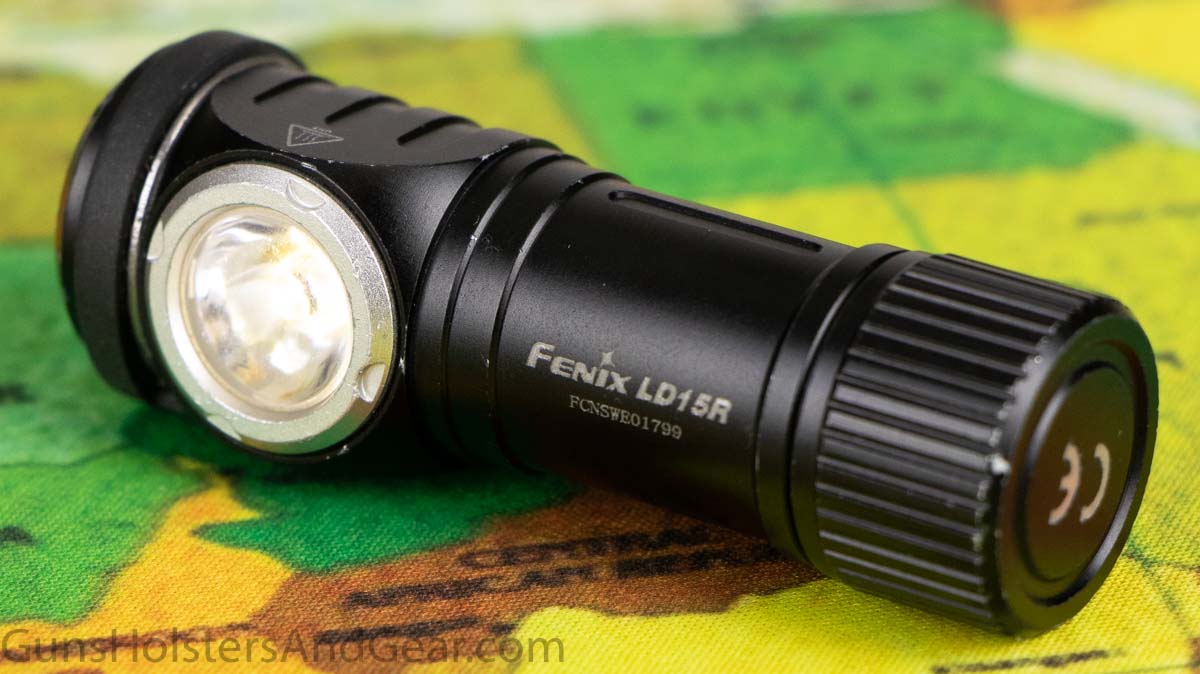
The first thing I noticed about this flashlight was its tiny size. It disappears into the palm of my hand, and with the included battery weighs less than 2 ounces. Throughout my evaluation of the flashlight, it rode in my right front pocket – jeans, shorts and dress slacks. At no point did it feel weird or out of place to be carrying the light in my pocket.
I was surprised at how useful I found the magnetic base. On many occasions I found myself crawling under my desk to route data cables, swapping a part on my clothes dryer or working on my car where I could just attach the flashlight to something for a virtual third hand.
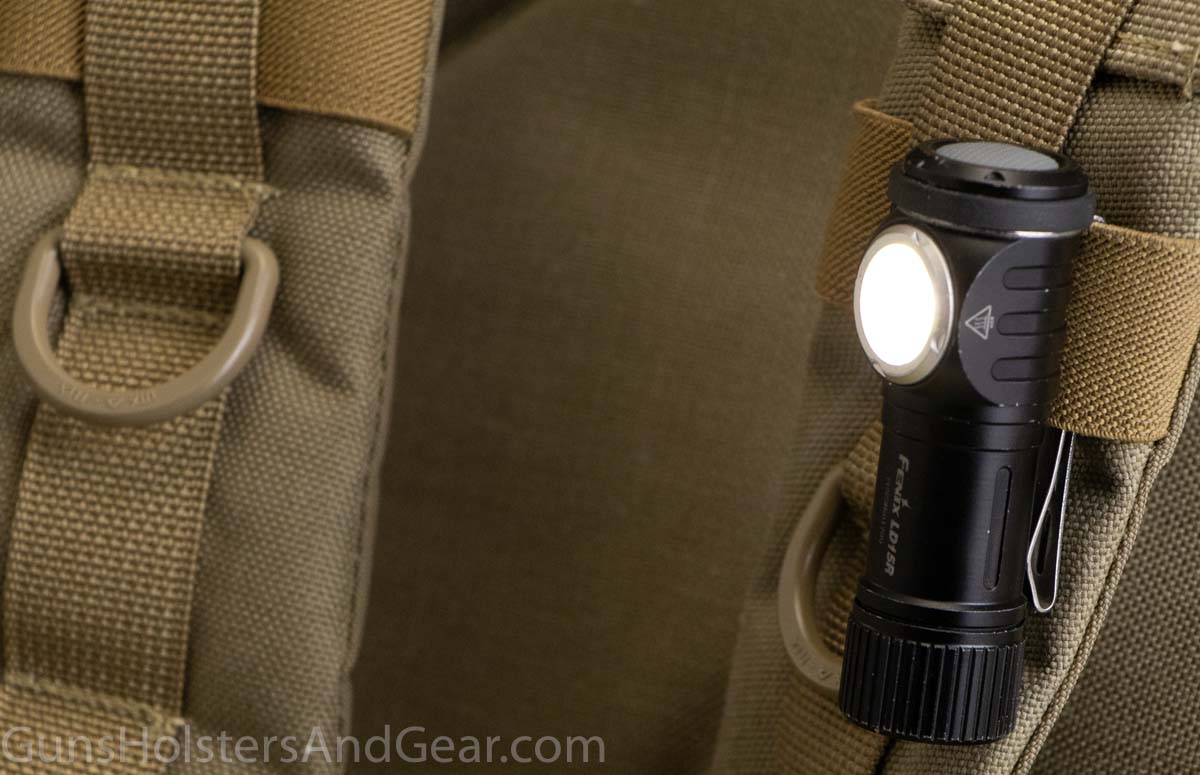
Although I did not use it much in my testing, the LD15R pocket clip is possibly more useful for other people. The two-way body clip is nearly as long as the rechargeable LED flashlight, and it works for hanging onto a pocket. However, it also is perfect for attaching to PALS-type or other webbing. You can use this to position the LD15R as a work light while on a camping trip or anywhere that the magnetic base isn’t helpful. This allows you to use it hands-free. Also, you can use it as a headlamp either with the included strap or an in improvised way.
White light is what we most often talk about in right angle flashlight reviews, but Fenix added red LEDs to this light for additional flexibility. Included in the package is the USB cable which helps with the battery status (battery level indication.)
Dual Power: USB & CR123A
Fenix gives you flexibility with how to power the LD15R. It comes standard with a USB rechargeable battery but also runs on a standard CR123A battery.
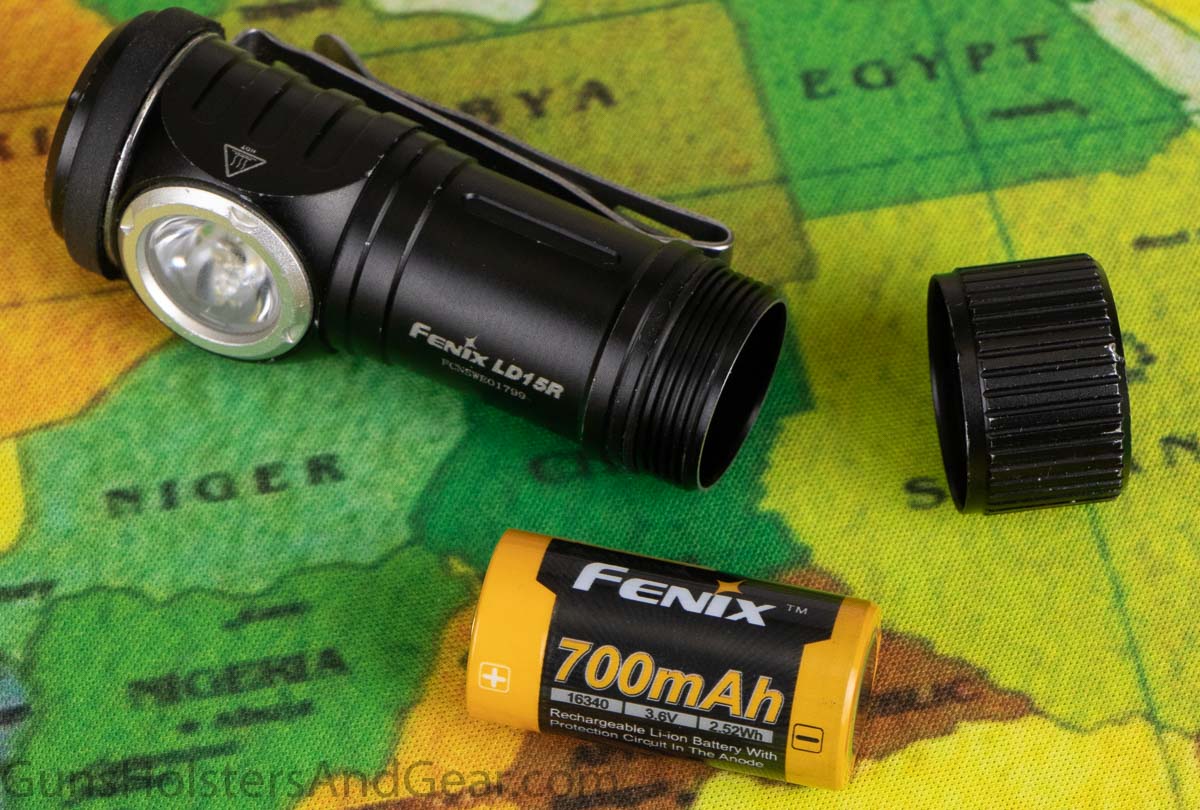
Included with the light is a 3.6 volt 700 mAh 16340 lithium ion (Li-ion) battery. It is Fenix branded and made in China. It charges inside of the flashlight via a micro USB port and an included micro USB charging cable. It can also be removed and charged externally. The 16340 rechargeable battery has a built-in protection circuit.
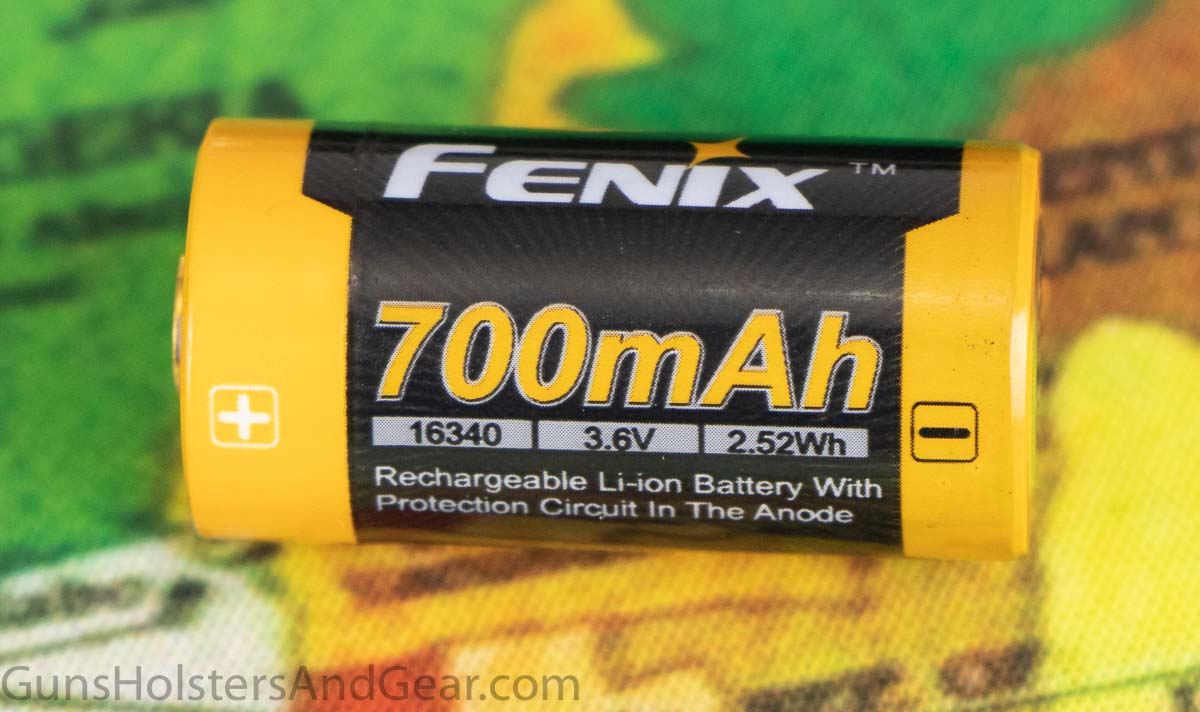
The light can also be powered by a single CR123A battery. This allows you to use the rechargeable battery on a daily basis, but in a situation where you are without power for a period of time, you can still fall back to lithium batteries that have a long shelf life.
On the head of the flashlight is the charging port with a rubber seal. The seal mates tight to the port and doesn’t get caught on your hand or other gear when using the flashlight. The company includes a spare o-ring for the tail cap.
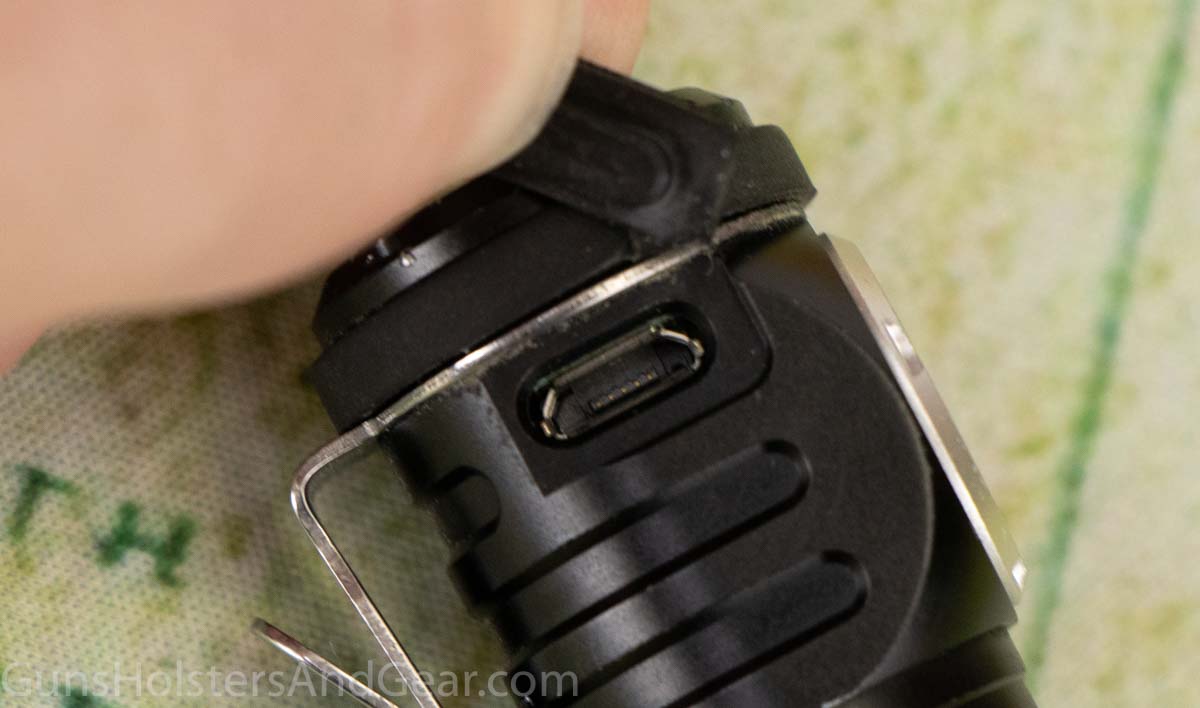
When the light is charging, you can see a red light under the switch. When the battery is fully charged, the visible light is green.
Controls
There is only one switch on the Fenix LD15R flashlight: a button on the top of the head. It allows you to turn on the light, alter output intensity and change between white and red light.
To turn the light on, press and hold the button for approximately 1 second. The light will activate at the same output level as when you last used it. The only exception is if you last used it as a red light. In that case, it will turn on in the low mode white light.
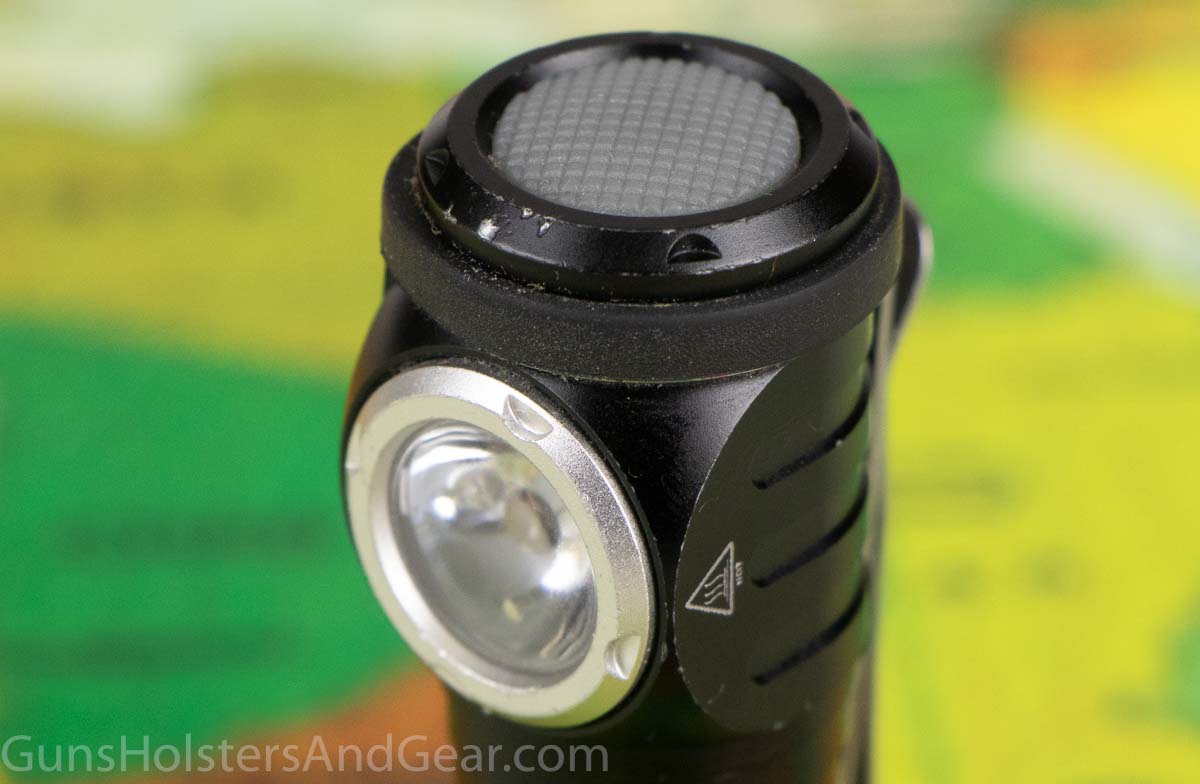
Once the light it on, you can press and hold the button for about one second to turn it off.
The CREE XP-G3 LED provides a natural light with a slight hint of blue.
To activate the red LED light, press and hold the button for about two seconds from the off position. The light will initially turn on as a white light then swap to red light. This is my main concern with the light – you get a flash of white light before it goes into the red light mode.
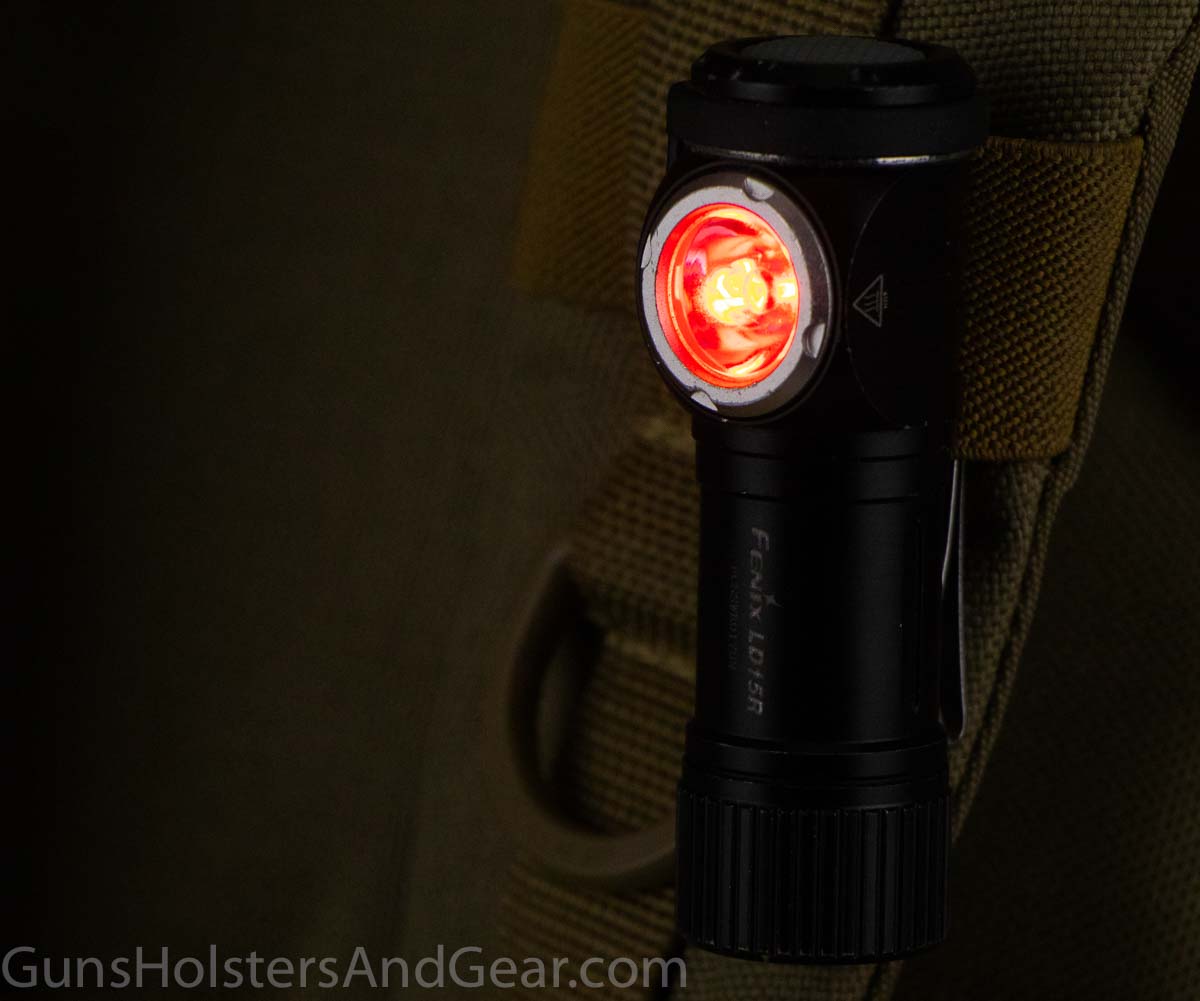
Once the red light comes on, it stays on even if you continue to hold the button down.
You can rotate through the output intensities of the white light by tapping the button once it is turned on. It rotates sequentially from low – medium – high – turbo.
Specifications
Here are the Fenix LD15R specs:
| weight (as stated by the manufacturer) | 1.4 oz (w/o battery) |
| weight (measured) | 1.9 oz (w/ included battery) |
| length | 2.8″ |
| impact resistance | 1 meter |
| water resistance | IP68 |
| total light output | 500 lumens/150 lumens* |
| peak beam intensity | 1,800 candelas/530 candelas* |
| stated runtime | 1 hr 20 min/2 hr 50 min* |
| beam distance | 85 meters/46 meters* |
| MSRP | $72.00 |
Testing
Over the years, I have developed a testing protocol that is designed to measure light output over time, heat generation, impact resistance and water resistance. My testing is influenced by the voluntary ANSI/PLATO FL 1 flashlight standard that tests multiple samples of flashlights in laboratory conditions. However, my tests are my own and do not adhere to the FL1 standard.
I highly recommend reading more about my flashlight testing and the FL 1 standard here.
Output Over Time
Fenix offers specifications of total light output (measured in lumens) and runtime for the different output modes of the LD15R. This is common in the flashlight industry, but it doesn’t tell the consumer “how much light for how long?”
According to the FL 1 standard, the light output measurement is essentially a peak measurement that happens shortly after the light turns on. The runtime is how long the light will run until the rechargeable flashlight winds down to a mere 10% of that initial output. It’s pretty easy to see that an unscrupulous manufacturer could game these specs and deliver a disappointing product.
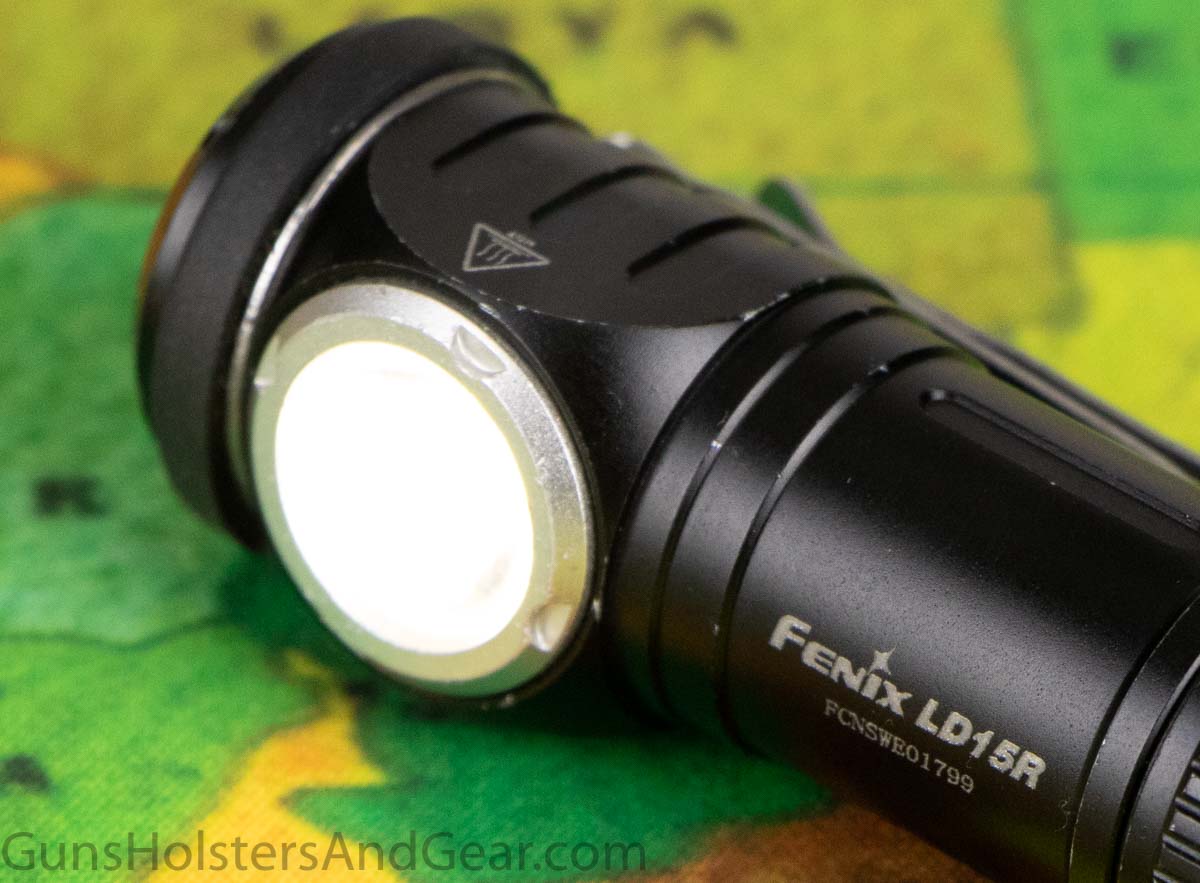
When I do my testing, I show how long the flashlight runs and at what output level as a percentage of its initial output.
For this Fenix LD15R, I ran the output over time test three times. The first was with the included 16340 battery in turbo mode. Since the turbo mode automatically steps down to a lower output level by design, I also tested the light with the 16340 battery in the high output mode.
Lastly, I tested the light with a Streamlight CR123A 3v battery. I use the Streamlight branded CR123A battery for all of my tests to remove batteries as a variable to provide a better flashlight to flashlight comparison.
Turbo Mode, 16340 Battery
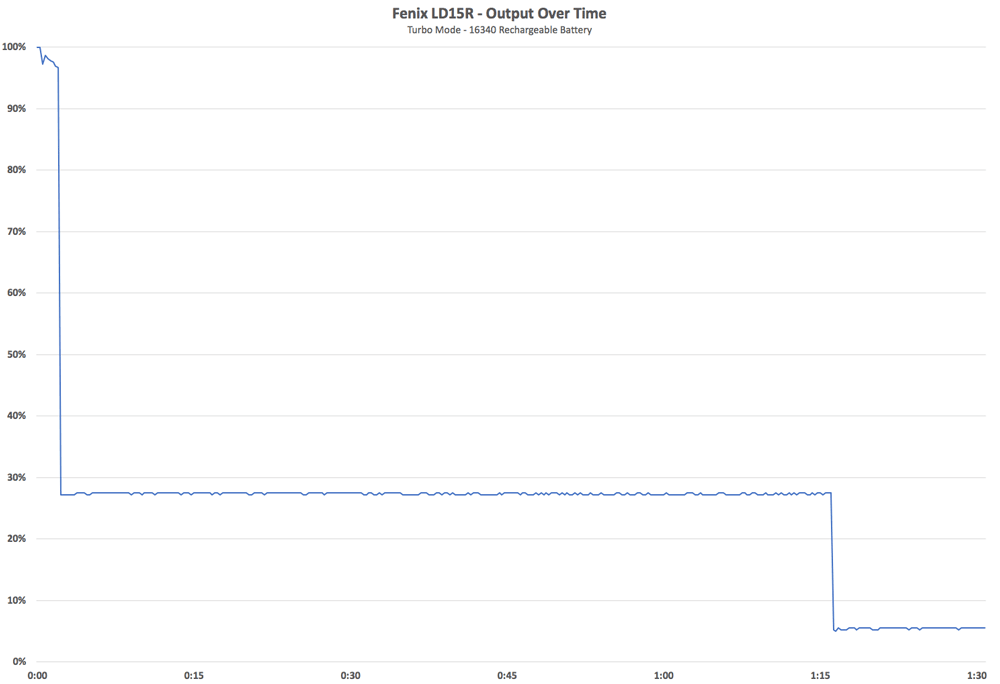
As I mentioned, the LD15R automatically steps down its power output in turbo mode. In my testing, I saw the power drop at the 2.5 minute mark.
The power drop is significant – it drops to less than 30% of its initial output. This roughly corresponds with the published specs of 500 lumens for the turbo mode and 150 lumens for the high mode.
In the reduced output mode, the flashlight puts out 27-28% power until the 1 hour 16 minute mark. Then it drops below the minimum 10% output threshold.
Fenix rates the LD15R as having a 1 hour 20 minute runtime in turbo mode. I would imagine that 4 minutes between my measurements and the published specifications is within a margin of error.
High Mode, 16340 Battery
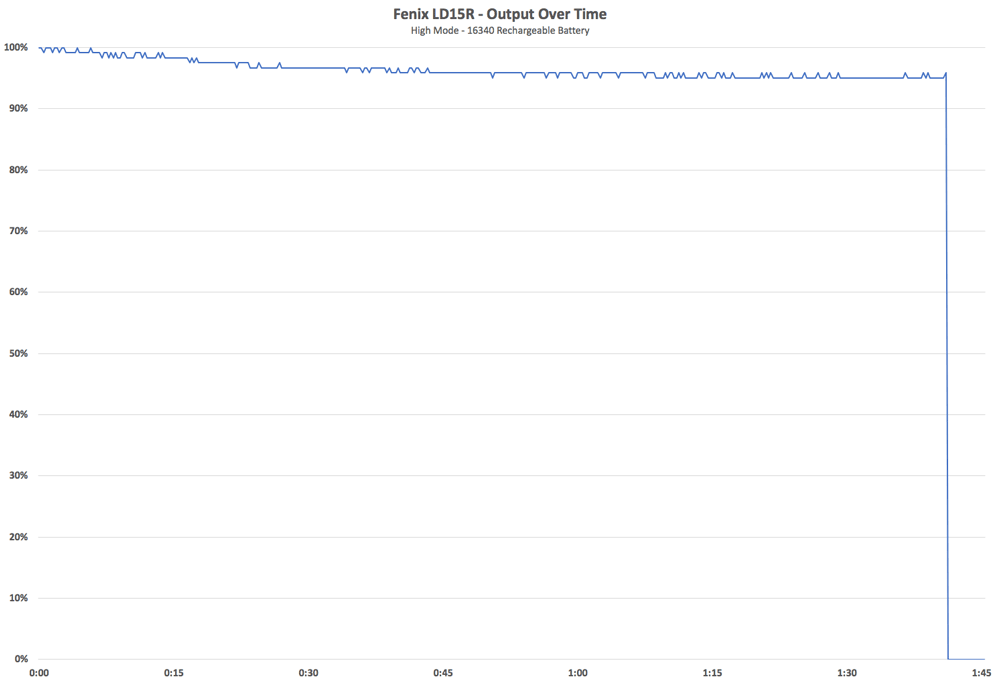
In high mode – rated by the company at 150 lumens – the LD15R throws more than 95% of its initial brightness for 1 hour 41 minutes. At that point, it drops to 0%.
I am impressed that Fenix did not game the system with this light. It gives nearly full brightness for the entire duration of the battery. This is commendable.
I am disappointed that the run time was less than the published specification, however. The spec shows a 2 hour 50 min runtime, but for my testing, the light came up more than an hour short. With a CR123A battery, things improved significantly.
High Mode, CR123A Battery
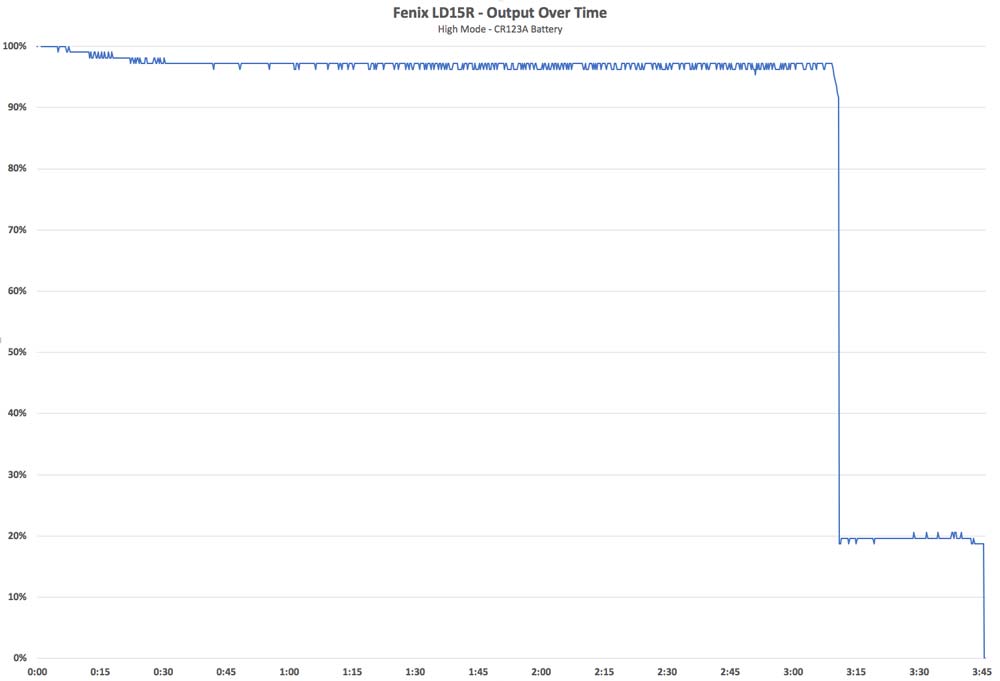
Although the equipment I have does not allow me to provide lumens measurements, I did measure about 17% less light output from the CR123A battery than I did from the 16340 battery. This was expected as there is a 0.6v difference between the batteries, which is about 17% less voltage.
The CR123A is able to hold more potential energy and the light’s output over time shows this.
With a single Streamlight CR123A battery, the Fenix LD15R in high mode ran at 96%+ for more than 3 hours. After that, it dropped to about 20% and continued on for another 30 minutes.
Heat Generation
All electronics produce heat during operation. As companies push flashlights to be brighter, one of the common byproducts is increased heat. A flashlight that becomes too hot to hold may not be ideal for your needs.
There is no standard for measuring heat output from flashlights, and I do not know of any company that publishes any data on its lights.
I tested heat generation for the same three modes and battery combinations I did for output over time.
Turbo Mode, 16340 Battery
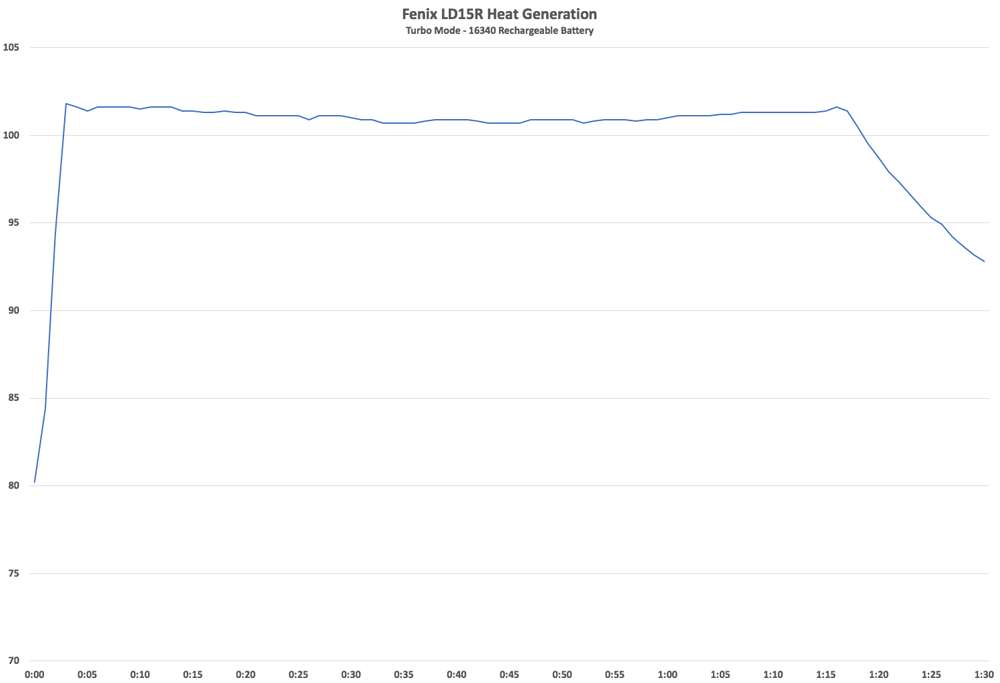
The turbo mode caused the LD15R’s surface to jump up to more than 100° F in the first 5 minutes. After that, it stayed mostly level until it began to cool around the 1 hour 10-minute mark. This roughly corresponds with the drop in light output.
While 100-105° F is significantly warm to the touch, it will not burn you, and you can still use the flashlight without gloves.
High Mode, 16340 Battery
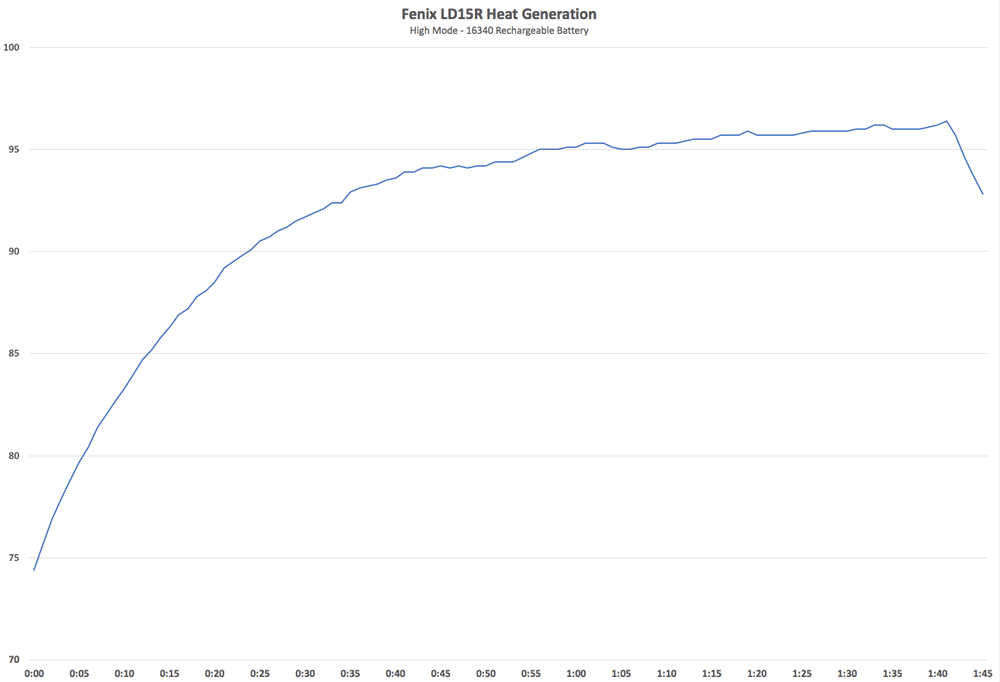
The lower light output in high mode corresponds with a lower surface temperature. In high mode, the flashlight never reached 100° F.
High Mode, CR123A Battery
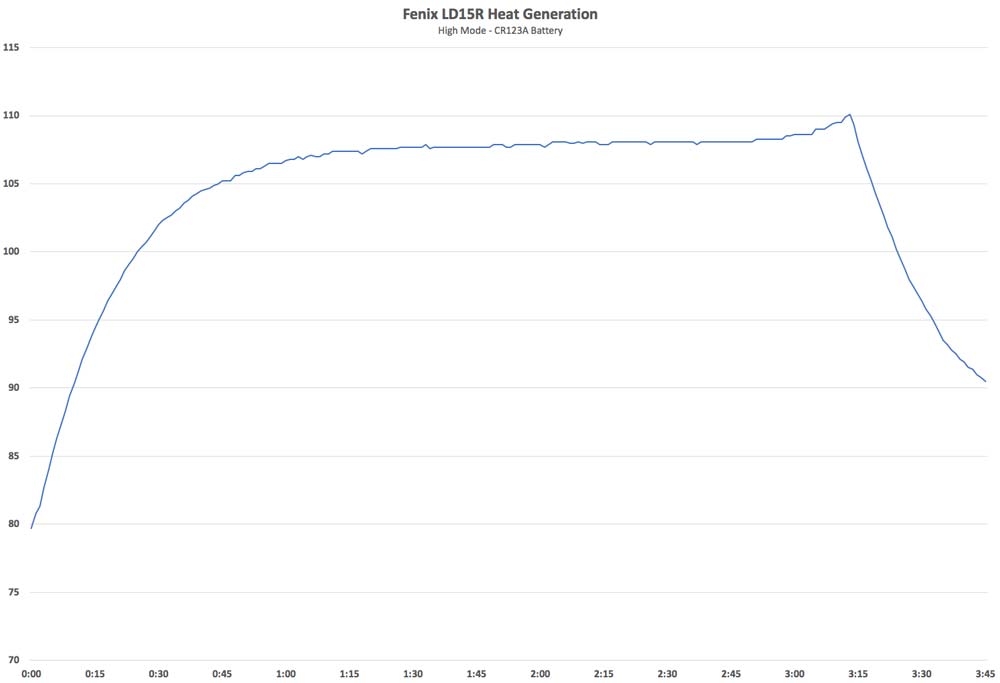
Interestingly, the Fenix LD15R ran the hottest with a CR123A battery. This may be a result of the lower battery voltage making the flashlight less efficient at producing light.
For most of the runtime, the light hovered between 105° and 110°. Right before the flashlight’s light output dropped, the temperature spiked above 110ËšF. This would appear to correspond with the battery’s voltage dropping significantly and the flashlight trying to maintain the same level of light output.
Even though 110° may be uncomfortable to hold, it is not likely to cause you any harm. I’ve tested other lights that can burn your hand. See my Wowtac A7 flashlight review for an example of a light that exceeded 200° F.
Visual Comparison
You’re not going to be blown away by the light emitted by the LD15R. However, the light is very useable and for the flashlight’s intended purposes, it is ample. Here’s a look at what you get.
This image represents a person standing between two cars at a distance of 7 yards. There are some streetlights in the background. It was shot with a Canon 80D DSLR (ISO 400 f. 8.0 0.25 seconds at 59mm). Drag the slider left and right to see the no flashlight/flashlight on images.


For comparison, here is the LD15R (left) compared to the SureFire G2X flashlight (right):


These images were taken at slightly different camera settings (ISO 400 f. 8.0 2.0 seconds) at seven yards.


This again compares the Fenix to the Surefire.


The point of these images is not to show that this task light is inferior to the SureFire tactical flashlight. Rather, they are to give you an idea of the relative amount of light you can expect from this little flashlight. While I use the LD15R as a work light, it can be used in a pinch for a more tactical role.
Impact Resistance
Impact resistance is commonly listed by companies as distances in meters. For example, Fenix states the impact resistance for the LD15R is 1 meter.
If a company adheres to the FL 1 standard, a one-meter drop test means that the light has to survive six drops onto cured concrete from a height of at least one meter. If the company does not adhere to that standard, who knows how many drops and onto what surface it used to achieve that specification.
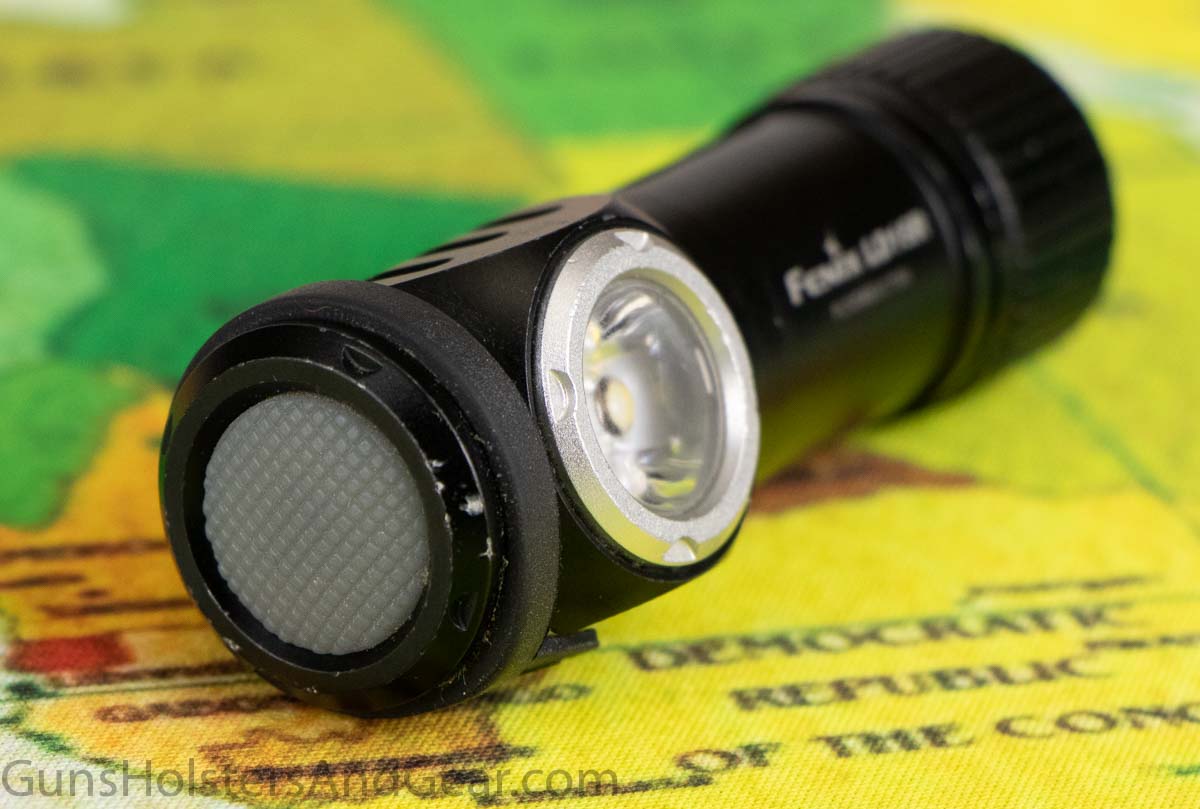
For my testing, I drop the flashlight six times onto a concrete sidewalk. This is similar to the FL 1 standard.
I dropped the Fenix LD15R onto concrete six times from a height of 1 meter. The flashlight worked after all six drops and showed no lens or switch damage. The body and head of the light did not appear to be cracked.
The finish of the light was obviously damaged. Numerous dings and nicks were plainly visible in the finish. However, all of these issues appeared to be completely superficial and did not seem to affect the operation of the light at all.
While I would like a more robust finish, I am more interested in function. From the perspective of “did it continue working”, the Fenix passed without a hitch.
Water Resistance
Water resistance is reported with an IP rating if the company adheres to the FL 1 standard. An IP rating is a measurement standard that is reported as IPxy. X is a single digit number that expresses a particle intrusion resistance rating and Y is a single digit number that expresses a water intrusion resistance rating.
Fenix rates the LD15R as IP68. This means the light is completely sealed against dust intrusion and can be submerged underwater to a depth of 2 meters for 30 minutes. Most lights are not IPx8 rated, so this is an impressive feature.
For my testing, I can test water resistance and can do so only to a depth of 1.5 meters for water submersion. However, at this depth, the flashlight had no water intrusion after 30 minutes. The flashlight continued to work as normal.
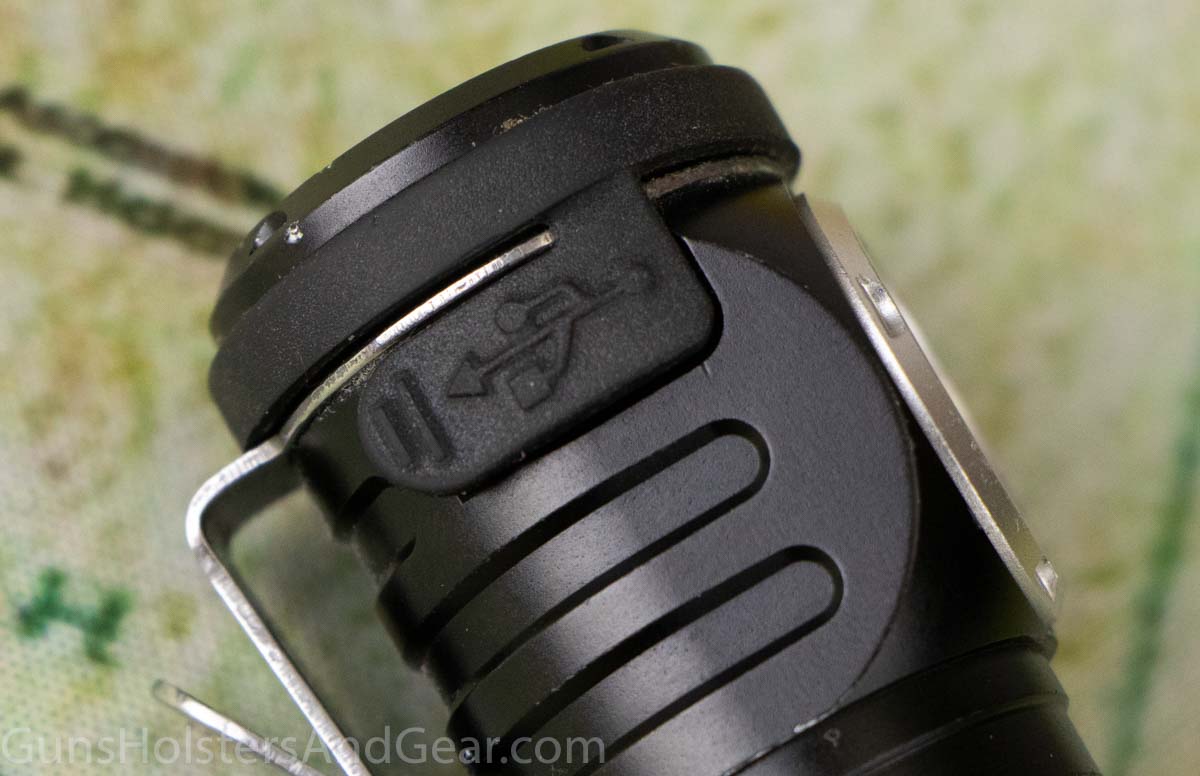
I do caution that for the light to be waterproof, the rubber flap over the charging port must be securely in place. It is easy for these to be dislodged and significantly reduce the flashlight’s resistance to water intrusion.
Final Thoughts
For a practical work light, the Fenix LD15R is easily my favorite flashlight. It is light and small – it slips into my pocket as soon as I get up and is dropped onto my dresser before bedtime. It goes everywhere with me.
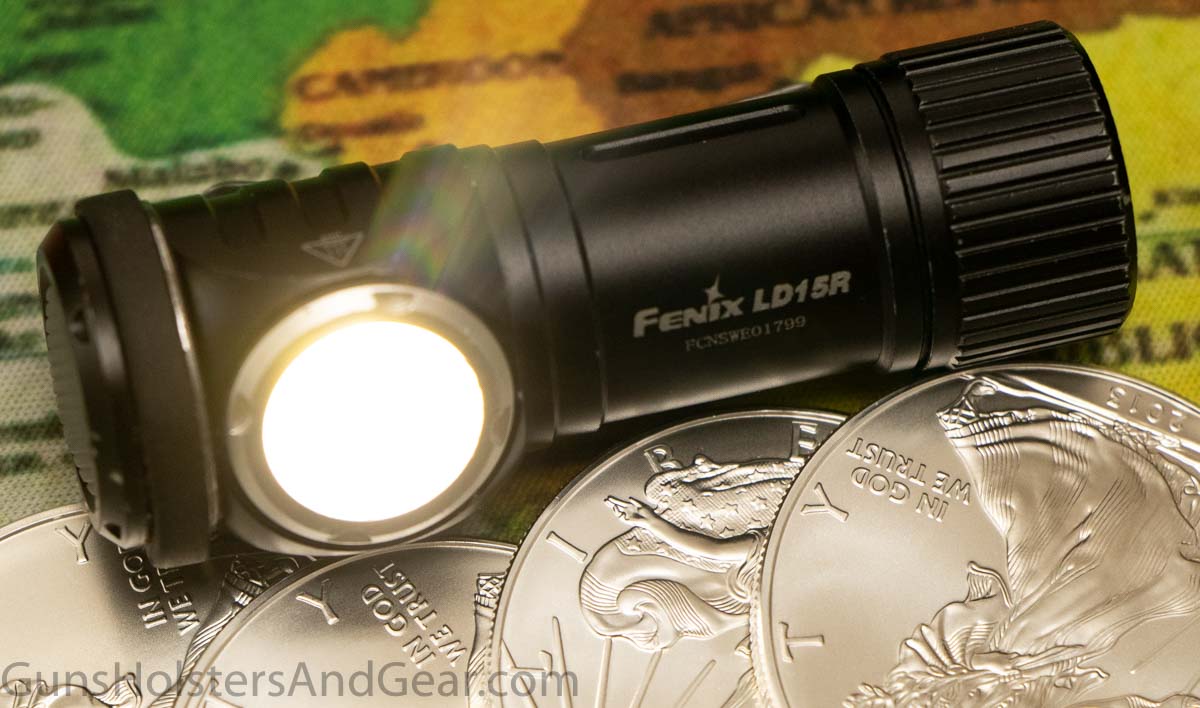
I have beat the snot out of this light. It rattles around in my pocket next to my keys and bumps against my Spyderco knife regularly. I’ve used it to work on cars, computers, appliances and landscaping projects. Anytime I need some (non-tactical) light, it is the first flashlight I reach for.
The magnetic bottom with the right angle head is exceptionally useful for all kinds of jobs. Even the clip is helpful for positioning the light.
The battery lasts a long time in practical use and recharges quickly. The switch is easy to use and works – even after a lot of abuse.
I cannot say enough about this flashlight. I thoroughly like mine and encourage you to get one as well. This may be the most practical product I’ve reviewed on the site.
Last Update: May 20, 2023
Where to Buy a Fenix LD15R
The Fenix LD15R is a great utility light. If you would like to purchase one, I encourage you to use my affiliate link to Amazon here.
If you would like a package deal that includes a second 700 mAh battery, this link can get you one for just a few dollars more.
Disclosure
I fully disclose all potential influences and biases that my impact my reviews. This is a standard I hold myself to and wished others in the media did as well. Sadly, many reviews are bought and paid for – even at websites you might think are trustworthy.
First, Fenix is not an advertiser or sponsor of this site, nor is any other flashlight company. I do not have any financial interest in Fenix or other flashlight companies.
Second, Fenix provided the flashlight for this review. They did so with the full knowledge that I thoroughly test all products and do not hesitate to tell you when a flashlight fails to perform to my expectations (see my Extreme Beam M600 and Factor Cossatot 1000 XL reviews.)
Third, I’ve had this light for more than a year. I don’t believe that any piece of gear should be reviewed after just a few minutes of use. In the case of a flashlight, I like to have months of hands-on time with them before I give you my thoughts. I carried this flashlight for about 16 months before I wrote this review.
Lastly, GunsHolstersAndGear.com is a for-profit site. I earn money through the use of affiliate links. These links go to companies like Amazon and Palmetto State Armory. Should you decide to purchase something from one of those companies, I make a small commission.
The links do not change your purchase price. I do not get to see what any individual purchases.
Questions and comments are welcome below. If you have any experiences with the LD15R, please share them below. For other readers, the additional opinions can help them make a decision if this flashlight is right for them.
I just ask that you refrain from profanity and personal attacks. This is a family-friendly site, and I want to keep it that way.
4 replies on “Fenix LD15R Review – Right Angle Rechargeable Flashlight for Utility Use”
Finally, an article that isn’t drooling over the latest bump in lumen output.
I’ve been carrying an Olight H1 Nova or H1R Nova for a few years now. These little right angle lights really are the perfect EDC Work lights.
I looked at the Fenix light but ultimately chose the Olight due to the stated run times.
Could you possibly do a review or comparison of the Olight? I would be very interested if their stated run times are true.
Hi John,
Believe it or not, I had the H1 Nova but lost it during an office move. I have no idea where it went to. Sadly, I had not run any testing on it prior to losing it. I’ve got it on the list for things to test.
For what its worth, I do have an S30R Baton III from Olight. I measured runtimes that suggest the Olight specs are accurate. I will have a full review on it and the M2R Warrior coming soon.
Thanks for reading!
-Richard
I love all the statistics you put together for this flashlight. It is always good to know what to expect from a piece of equipment before you’re in the field with it and NEED it to preform.
I use an Emisar D4S as a primary light, with the Fenix LD15R as a secondary. The perpendicular light clips really nicely onto a chest rig or chest pocket and give you hands-free illumination. The magnet on the tail cap is a fantastic feature if you’re in a working environment where you can stick it to something like machinery or a car.